Rosy-Finches
at Sandia
Crest, New
Mexico 
Elevation
10,678 feet
|
|
|
READ/POST INQUIRIES
AND LATEST SIGHTINGS REPORTS HERE IN these FORUMS:
»»ENTER SANDIA CREST  BIRDING FORUM««
BIRDING FORUM««»» ENTER PEMBROKE PINES FLORIDA  BALD
EAGLE NEST WATCH FORUM ««
BALD
EAGLE NEST WATCH FORUM «« |
| Blog: Rosyfinch Ramblings | Cedar Crest Backyard Birds | Ken's Family Home Page | ||||
| Birding the Sandias | Birding Manzanos/Manzanitas | Checklist: Birds of the Sandias | ||||
|
ROSY-FINCH
SIGHTINGS,
BLOGS & CORRESPONDENCE: |
SANDIA
CREST
TRAVEL &
BIRDING INFORMATION: |
BIRDING THE
SANDIAS
&
ALBUQUERQUE AREA:
|
||||
|
RESEARCH
PLANS, PARTNERS,
LINKS
& REPORTS:
|
PHOTOS AND FILM CLIPS: | ROSY-FINCH
SPECIES ACCOUNTS & BIOLOGY: |
||||
|
||||||
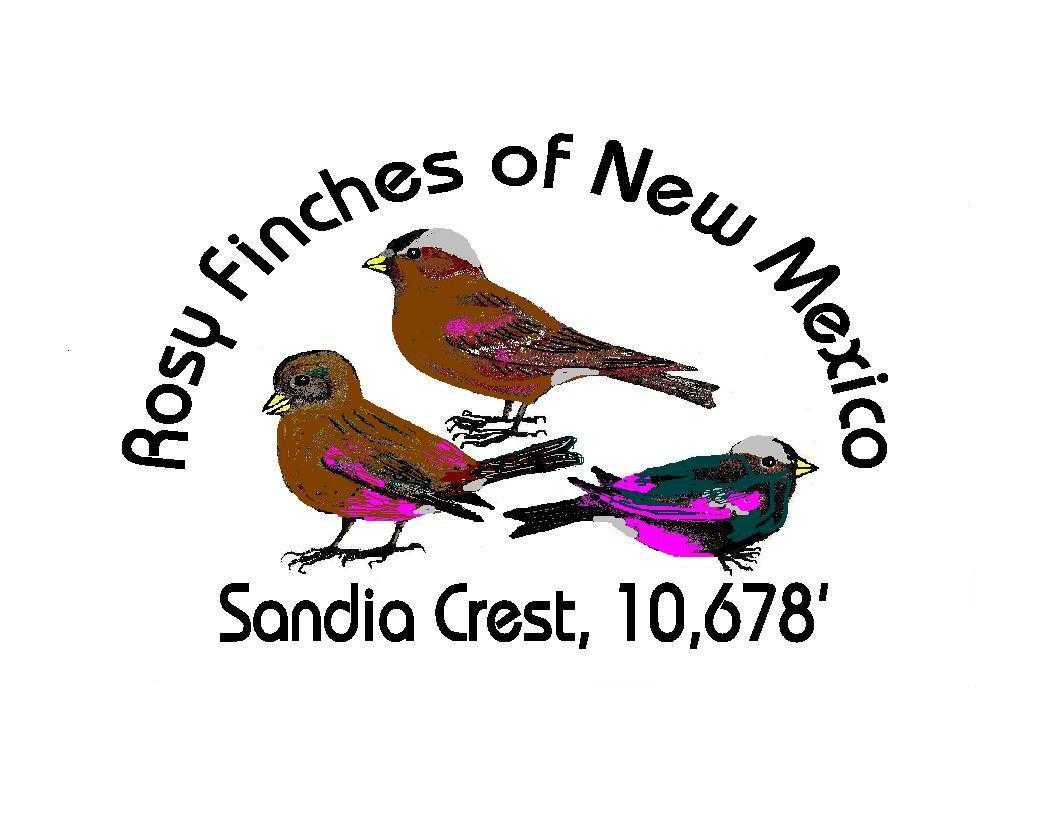 "If
the birds stick here for a few
years, this could easily become the 'canonical' location for worldwide
birders to get their rosyfinches since it is only an hour's drive from
a major international airport and the road is paved, maintained, and
clear throughout the winter." (Jerry
Oldenettel full text)
"If
the birds stick here for a few
years, this could easily become the 'canonical' location for worldwide
birders to get their rosyfinches since it is only an hour's drive from
a major international airport and the road is paved, maintained, and
clear throughout the winter." (Jerry
Oldenettel full text)| WebCam
Views-- The golf course camera sometimes updates irregularly. Even though snow may be melting down at the golf course, there may be frequent snow squalls up at the Crest. The parking lots are usually kept clear at Crest House, the ski area, and the Snow Play area. The lower road down to the Capulin Spring "bird log" is closed. There have been past reports of Northern Pygmy-owl sightings, either at the entrance to the Snow Play or the base of the ski area. PAA-KO RIDGE GOLF COURSE LIVE VIEW 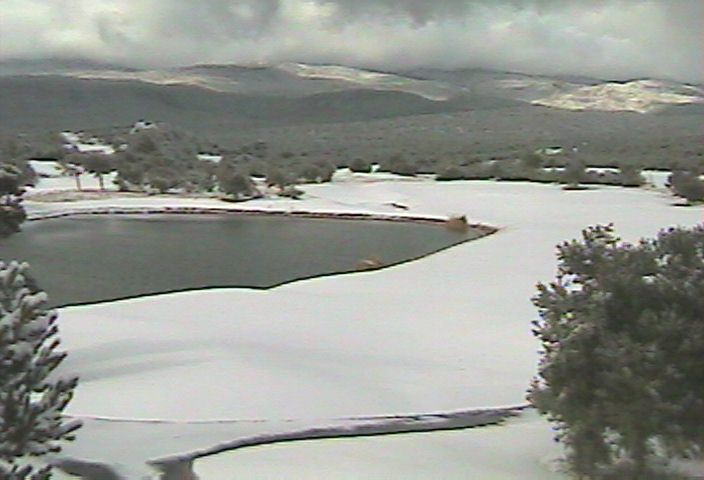 The east slope of Sandia Crest
is in the far central background, just to the right (north) of the ski
runs that may be visible when there is snow cover. Click
on the image
for a live
enlarged view of
conditions at the golf course (6,800 feet elevation), two miles north
of the base of the Crest Road,
where it is usually about 11 degrees warmer than at the top. Since the
east slope of the Sandias is heavily forested, the snow line may not be
clearly demarcated. There is usually much more snow on the
ground at Sandia Crest. Check
the weather
and road information links below. The east slope of Sandia Crest
is in the far central background, just to the right (north) of the ski
runs that may be visible when there is snow cover. Click
on the image
for a live
enlarged view of
conditions at the golf course (6,800 feet elevation), two miles north
of the base of the Crest Road,
where it is usually about 11 degrees warmer than at the top. Since the
east slope of the Sandias is heavily forested, the snow line may not be
clearly demarcated. There is usually much more snow on the
ground at Sandia Crest. Check
the weather
and road information links below. KOB-TV CITY CAM
 This
view of downtown Albuquerque (elevation 5,312'), when aiming towards
the east, shows Sandia Crest
(10,678') in the far left background. South Sandia Crest (9,702') is
the higest point in the right background. While snow melts quickly in
the valley and on the west side of the Sandias, it sometimes persists
all winter at Sandia Crest. Click on the image for other
local WebCam views. This
view of downtown Albuquerque (elevation 5,312'), when aiming towards
the east, shows Sandia Crest
(10,678') in the far left background. South Sandia Crest (9,702') is
the higest point in the right background. While snow melts quickly in
the valley and on the west side of the Sandias, it sometimes persists
all winter at Sandia Crest. Click on the image for other
local WebCam views.Don't miss seeing this local PBS documentary about the Sandias that includes a segment on the rosy-finches, now archived on-line. Click on 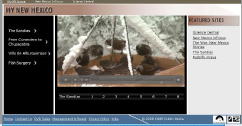 the thumbnail to the
left, to view the movie on knmetv.org/ The
four chapters of this film document a project for
a one-night spectacular light show, but also delve into the cultural,
geologic and natural history of the mountain. Chapter One describes the
ecology of the
Sandias, and features the rosy-finch banding project near the end.
There are great views of the birds taken at the Crest House, at the
feeders and in the hand, not to mention wonderful photography that
makes me really miss my former mountain home! the thumbnail to the
left, to view the movie on knmetv.org/ The
four chapters of this film document a project for
a one-night spectacular light show, but also delve into the cultural,
geologic and natural history of the mountain. Chapter One describes the
ecology of the
Sandias, and features the rosy-finch banding project near the end.
There are great views of the birds taken at the Crest House, at the
feeders and in the hand, not to mention wonderful photography that
makes me really miss my former mountain home!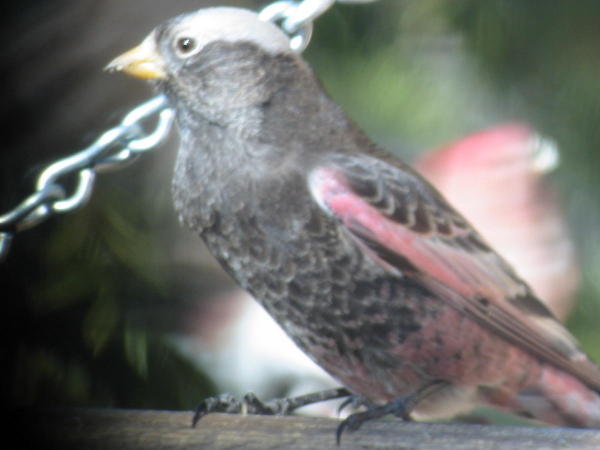 Black
Rosy-Finch
through
windows of Deck at Crest House JAN 30 2003 Canon A40/ KOWA 77mm x 20
zoom
(Click on picture for larger image) ©
Ken
Schneider Black
Rosy-Finch
through
windows of Deck at Crest House JAN 30 2003 Canon A40/ KOWA 77mm x 20
zoom
(Click on picture for larger image) ©
Ken
Schneider
GENERAL INFORMATION AND GUIDELINES ABOUT OBSERVING ROSY-FINCHES AT CREST HOUSE (November through March)Please
sign the log near front door -- Nick Harada, Manager, and the
staff at Crest
House expect the finches
to attract many visitors, and we believe that birders are having a
positive impact on business. Show your
support by
purchasing souvenirs and food. Rosy-Finch Patches, Pins and
T-shirts
are now
available. Sales of these items tell the merchant that
birders
are important to the local economy!
A word about counting -- we count the largest number (total and species) seen at any one time during our period of observation. Therefore the numbers may not add up. For example, one day we saw a flock of over seventy birds, in which Black and Gray-crowned Rosy-Finches predominated, with only 4 Brown-capped species. They departed and were promptly replaced by a small flock of 16 with 10 Brown-capped individuals. We reported 10 Brown-cap's and 35 Blacks, based on the separate counts. The feeders need filling every two to three days and the rosy-finch feeding program volunteers can not always get up there. Join the cadre of volunteers who are willing to help out. Thanks to those who have left donations of seed in secure bags (sealed or zip-lock; Hull-less "Patio Mix," or hulled sunflower seed only-- NO MIXED SEED!). Please give it to the US Forest Service volunteer at the Visitors Center near the gift shop door, or directly to one of the Crest House staff. (Cash donations cannot be accepted, but thanks for offering). If you happen to see that the feeders need filling, please advise Alan Mickelson or one of the Crest House staff, but PLEASE DO NOT fill the feeder or spread seed yourself. NOTE that the deck feeder is always stocked with hull-less seed to reduce the amount of litter. Do not insist that employees fill the feeders immediately, as they have their own work to do, and our volunteer project is carried out through the courtesy of Two Mile High, LLC and Crest House management. Please do not scatter seed on the ground or pavement. Do thank the staff of the Crest House for their hospitality and consider purchasing souvenirs and snacks. Crest House is a private business that operates in a newly expanded private building constructed on land that is leased from the US Forest Service. This is the only accessible "disturbed" land on Sandia Crest, as the US Forest Service prohibits feeding of wildlife in the surrounding Wilderness Area, so we are most grateful for the hospitality that Crest House extends to birders. Please respect their 10:00 AM opening time, even though staff may arrive earlier to set up for business. Keep
in mind that non-birding customers and visitors have every right to
enjoy the view from
the deck,
even when their activities may cause the birds to stay away from the
deck feeder. PLEASE do not occupy a table if you are not
purchasing food or drink. Take advantage
of every chance to orient visitors to these unique birds.
Allowing them a brief glimpse through your
scope or binoculars may turn some of them into birders for life, or at
least help them understand why you are enjoying a different view from
the Crest House. More than once we have noticed they gain
respect
for your wishes not to flush the birds, and may even become "lookouts"
for the next flock!
Please keep your coats and equipment off the dining tables, so that other visitors are free to sit down and eat. When you get home, be sure to enter your observations into the Cornell Lab of Ornithology data base at eBird.org.
|
Please be advised that the Crest House Staff allow only five members of the banding crew to enter the Crest House BEFORE opening time to set up , etc. However, they would appreciate it if the other banders, visitors and observers would respect the 10:00 AM opening time. Prior to the opening time, all the staff have not yet arrived and finished preparing the building for the day. Some of the staff can be seen in the building earlier in the morning because there are things they must do BEFORE opening the doors at 10:00 AM. Please be considerate and do not plan to observe the banding or the birds from inside the Crest House until after the 10:00 AM opening time. We also wish to thank those who left seed. Note that if you do wish to donate seed, the "hull-less" or "patio" style is now in use as it causes the least problem with waste. No Nyger seed, please, as it especially poses cleanup problems and blows all around. Please do not leave bags of seed outside, as the "critters" quickly get into it. Neither the Crest House or the US Forest Service will accept cash donations, but we do appreciate those who have offered. Please do not scatter seed on the deck, parking lot, or anywhere in US Forest Service lands. IMPORTANT Anyone who attempts to ascend the Crest Road during or soon after a snow event should be aware of the dangers. Even our SUV with "low-low 4WD" and limited slip differential sometimes was not up to the task. My best advice to birders bent on seeing the Rosies is to defer visiting until the State Highway Department has had a chance to plow and sand the road, which may be 24 hours after the snow stops falling. The crews do their utmost to clear the first seven miles up to the ski area, but even their big trucks can find the going increasingly difficult as the 8,000 foot mark is approached (at about Capulin Spring).The Crest House is a private business that depends on its employees to provide service to the public. It is not unusual for the restaurant and gift shop to remain closed for safety and security reasons if the parking lot is iced over or under 3 foot drifts or if its staff cannot make it to work. The management and staff have been most courteous to birders and welcome our presence even if we do not always make purchases. The banders have often helped the staff open the restaurant by sweeping and arranging tables before opening time at 10:00 AM. I admit to sometimes being guilty of cluttering the tables with outerwear and blocking the view with my spotting scope while other patrons were trying to enjoy lunch and landscape.Life can be very harsh at 10K feet, and one should not visit without being prepared. I often tell people to plan to visit at least two days, allowing time to adjust to the altitude and provide extra observation time in the event the birds or the weather do not cooperate. Dress warmly so that you can observe the birds from outside the Crest House if necessary. If you have specific questions about the rosy-finches or general birding in the Sandia Mountains, or wish to relate a report on your visit, please visit and post to the FORUM. Following are a few more suggestions about how birders may increase their enjoyment and extend courtesy to others while visiting the Crest House. |
 After
your visit,
please report your observations on the ROSY-FINCH FORUM. After
your visit,
please report your observations on the ROSY-FINCH FORUM.
Also monitor and post sightings to the NM Rare Bird Alert or directly by e-mail to Matt Baumann who compiles the New Mexico RBA. We have relocated to Miramar, Florida. Only 8 feet above sea level, our new home (rear view to the left-- click on thumbnail for more views of our home and lake) is 42 feet from the 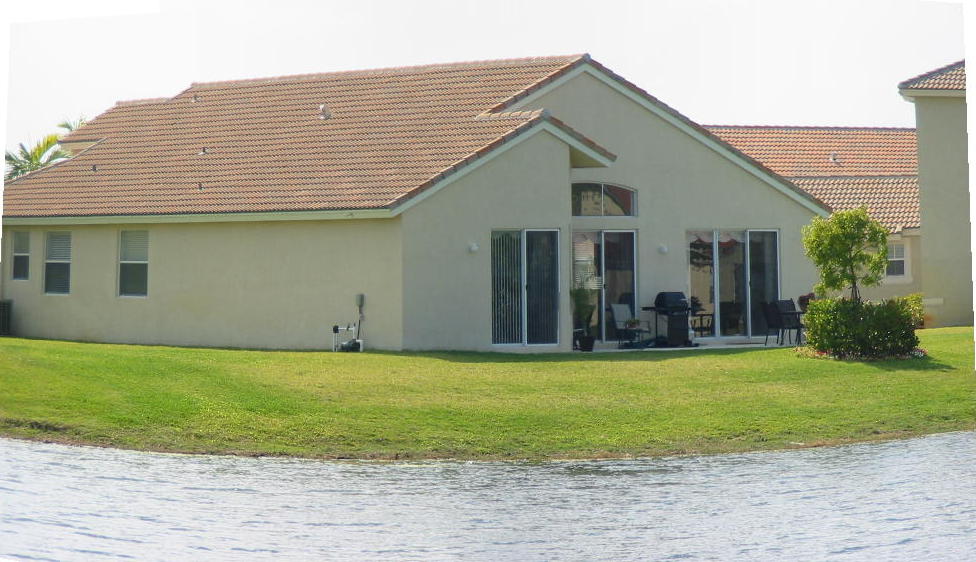 shoreline
of a lake at the edge of the
Everglades. Our "yard birds" now include Wood
Storks
and Anhingas and even a hurricane-driven flock of Greater Flamingos.
In May,
2004, Fran
Lusso and Dave
Weaver,
our neighbors and fellow USFS Volunteers assumed our
duties at Sandia Crest. Fran and Dave
were new to New Mexico, in about the same position we
found ourselves when we moved there from Dallas in 1993. They
were already experienced in providing interpretation to the public at
the Sandia Crest House Visitors Center. After Dave was injured in
2012, Alan Mickelson took over the duty of tending to the feeders. Alan
tries to get up there once a week, and the banding team is there on
weekends to fill the feeders. We will continue to
keep
up ROSYFINCH.COM indefinitely until/unless someone else wishes to take
on the task of Webmaster. We
started the rosy-finch feeding project in 1999, and welcome this
opportunity to remain virtual "observers" and "residents"
of our beloved New Mexico. shoreline
of a lake at the edge of the
Everglades. Our "yard birds" now include Wood
Storks
and Anhingas and even a hurricane-driven flock of Greater Flamingos.
In May,
2004, Fran
Lusso and Dave
Weaver,
our neighbors and fellow USFS Volunteers assumed our
duties at Sandia Crest. Fran and Dave
were new to New Mexico, in about the same position we
found ourselves when we moved there from Dallas in 1993. They
were already experienced in providing interpretation to the public at
the Sandia Crest House Visitors Center. After Dave was injured in
2012, Alan Mickelson took over the duty of tending to the feeders. Alan
tries to get up there once a week, and the banding team is there on
weekends to fill the feeders. We will continue to
keep
up ROSYFINCH.COM indefinitely until/unless someone else wishes to take
on the task of Webmaster. We
started the rosy-finch feeding project in 1999, and welcome this
opportunity to remain virtual "observers" and "residents"
of our beloved New Mexico.FEEDER LOCATIONS Two feeders are now in use: Feeder #1 is to the SE of Crest House, and is visible from the lower parking lot and the Gift Shop picture windows; #2 is on the west deck, visible from the dining room. The location of trapping and banding may take place on the deck or at feeder #1, at the discretion of the banding team and Crest House management..
In
March, 2003 Ken took a panoramic
view from the deck of the Crest House. Click here for
a
view that will scroll itself in your browser.
|
  |
Support NM
Department
of Game and Fish Non-Game Share with WIldlife
Program. Visit their Web page for lists of Threatened and Endangered Species, and lists of projects. |
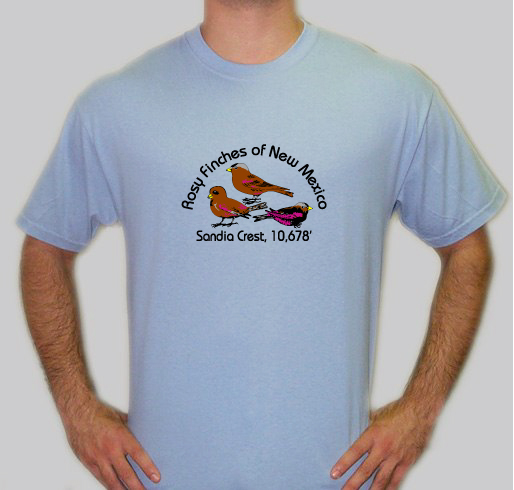 3"
Cloth
Patch
3"
Cloth
Patch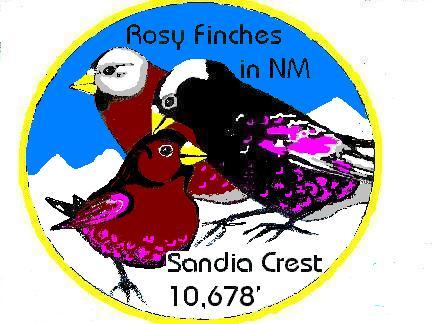
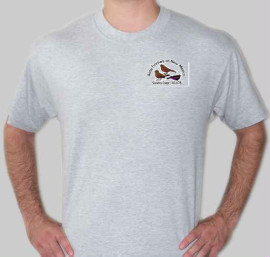 1" Metal Pin
1" Metal Pin